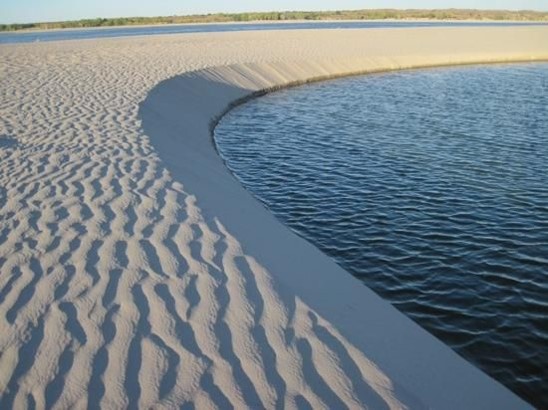Sandpit Lake Basics – What is happening in the water?

The last “Sandpit Lake Basics” article talked about some of the basic features of sandpit lakes from the water source to the physical features of sandpit lakes. This article will focus on what is happening in the water of a sandpit lake – something called the limnological characteristics.
Temperature and Thermal Stratification
Sandpit lakes are primarily influenced by groundwater inflow. Groundwater entering a sandpit is relatively cold, but in the Nebraska summer time, the surface of the water is warmed by the sun. This means that the coldest (and more dense) water is at the bottom of the pond and the warmest (and less dense) water is at the top. The result is that the cold and warm water separate. This is called thermal stratification.
Chemistry and Chemical Stratification
Groundwater entering a sandpit lake will contain very little, if any, oxygen. If there is no mixing of the top warm layer and the bottom cold layer there will be very little oxygen in the deep cold water.
Oxygen in sandpit lakes is often produced from photosynthesis by plants. This requires a certain amount of light to penetrate through the surface of the water. However, at some depth in the water, called compensation depth, there is not enough light to support photosynthesis. At this point bacteria, which are decomposing plants and other organisms, actually use up more oxygen than is being produced. Below this depth in the water, oxygen becomes depleted and water becomes stagnant. This chemical stratification usually occurs around mid-summer in Nebraska sandpits that have no man-induced mixing, such as aeration.

What does this mean?
Fish and other oxygen-dependent organisms cannot live in the deeper water (below the compensation depth), even if the water temperature is preferred. This reduces the amount of fish that a sandpit lake can support. The oxygen-depleted, water stagnation also contributes to excessive algae blooms because it can hold nutrients like phosphorus in a form that will rise up through the water column to the surface and be used by algae.
Turnover
During a Nebraska spring and fall, sandpit lakes will mix the top and bottom layers of waters as the surface and deep water temperatures are near the same and the winds blowing across the surface are strong enough to create mixing. This sounds like a positive action, but can result in a fish kill. The severity of the kill depends on the amount of oxygen remaining in the mixed sandpit lake after the oxygen depleted deep water mixes with the oxygenated surface water.
This is also a time where you might expect a minor algal bloom as nutrients from the bottom move towards the surface. However, this should not be confused with pea-green algal blooms which occur in mid-summer as a result of nutrient movement in stagnant water.

More Information
Do you need some technical assistance with your sandpit lake? Contact your area Fisheries Biologists or the Private Waters Specialist for further information. You can also find resources with your local UNL Extension Agent, the Nebraska Department of Environmental Quality, and Private Consulting Firms.
This article was reviewed by Mike Archer, Nebraska Department of Environmental Quality
Sign up for updates from UNL Water
